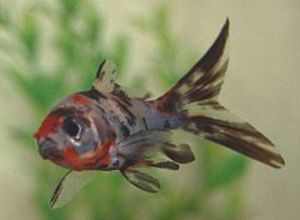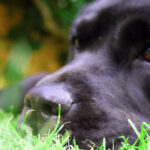Shubunkin is a musical-sounding word that refers to a hard-to-describe color pattern in goldfish. Perhaps the closest color pattern shubunkin can compare to is the blue merle pattern seen in some dog breeds like Australian shepherds. A shubunkin goldfish is blessed with a calico patchwork that can contain black, shades of gold, blue and white. This is a very rare color pattern and so it is much more expensive than other colors of goldfish.
There are three types of shubunkin goldfish, named for their places of origin — the London shubunkin, the Bristol shubunkin and the American shubunkin. However, the color first appeared in Japanese goldfish bred by Kichigoro Akiyama around 1900, but there doesn’t seem to be a Japanese shubunkin, although sometimes the Americans are referred to as “Japanese.” But the word “shubunkin” is Japanese. It does not have a direct English translation, although some websites like Wikipedia translates it as “red brocade”. Look at the color of a shubunkin goldfish and there’s your translation.
The Types
The American or Japanese shubunkin have a conformation similar to comet goldfish, however their tails are often larger and can droop more than that of comets. The ends of the tails can be pointed. Otherwise, they act exactly like comet goldfish. Ideal Americans have a body depth 3/8 or less than the lengths of their bodies.
The London shubunkin is built like a common goldfish. It lacks the spectacular tail and streamlined body shape. However, some consider the Londons to be toughest of the trio.
The Bristol shubunkin, also known as the Britsol blue shubunkin, has fins somewhere between the length of the London and the American/Japanese. Its tail fins have round ends as opposed to sharp ends. It is built like a comet.
Size
Shubunkins are like comet and common goldfish in that they can grow to about four inches in at least a 20 gallon aquarium but can grow up to 16 inches in a pond. Despite their brilliant coloration, these fish are arguably tougher than koi. They do well in ponds or aquariums.
They should not be put in bowls, unless the bowl is at least five gallons large and the owner is committed to cleaning the water every day. Like all other goldfish, shubunkins excrete a lot of waste. This makes bowl water quickly uninhabitable. They do much better with filtration systems that keep water moving.
Care
Unfortuantely, shubunkins are not noted for living as long as a common goldfish. Just exactly why is unknown. It could be due to their coloration. The blue effect is actually a pearly grey made by nacreaous cells in the scales. When sunlight hits the scales, they appear blue. These nacreaous scales contain a gene to make a gleaming metallic color and another gene for a matte effect.
Shubunkins are fast swimmers and should only be placed with comet goldfish, common goldfish or (if in a pond) koi. Otherwise, they will eat all of the food available and leave slower-swimming goldfish to starve. Plecostomus catfish do well in ponds with them but they have mixed results when placed in an aquarium with shubinkins or any other type of goldfish.
References:
“Goldfish: A Pet Owner’s Manual.” Marshall Ostrow. Barron’s; 1995.
“Goldfish.” Bernice Brewster and Nick Fletcher.” Bow Tie Press; 2004.
Bristol Aquarists’ Society. “Bristol Blue Shubunkin.” http://www.bristol-aquarists.org.uk/goldfish/bshub/bshub.htm
American Goldfish Association. “American Shubunkin.” http://www.americangoldfish.org/new_page_141.htm








